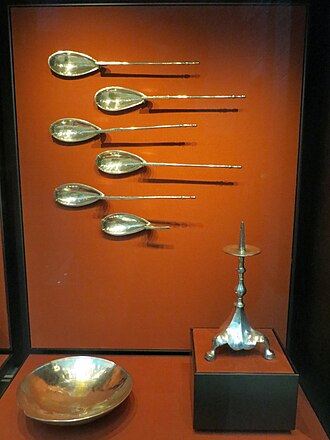노마에 감마2
Gamma2 Normae| 관측 데이터 Epoch J2000.0 이쿼녹스 J2000.0(ICRS) | |
|---|---|
| 별자리 | 노마 |
| 우측 상승 | 16h 19m 50.42227s[1] |
| 탈위임 | −50° 09′ 19.8223″[1] |
| 겉보기 크기 (V) | 4.02[2] |
| 특성. | |
| 스펙트럼형 | K0III[3] |
| U-B색지수 | +1.16[2] |
| B-V색지수 | +1.08[2] |
| 아스트로메트리 | |
| 방사 속도 (Rv) | -28.9±0.7km[4]/s |
| 고유 운동 (μ) | RA: -1975.71mas[1]/yr Dec.: −52.25[1]mas/yr |
| 시차 (π) | 25.33 ± 0.20[1] mas |
| 거리 | 129 ± 1 리 (39.5 ± 0.3 pc) |
| 절대치수 (MV) | 1.057[5] |
| 세부 사항 | |
| 미사 | 2.16[5] M☉ |
| 루미도 | 51[6] L☉ |
| 표면 중력 (log g) | 2.80[5] cgs |
| 온도 | 4,699[5] K |
| 금속성 [Fe/H] | 0.23[5] 덱스 |
| 기타 지정 | |
| 데이터베이스 참조 | |
| 심바드 | 자료 |
| 아리친스 | 자료 |
감마노마이는2 γ노르에서2 라틴어로 표기된 항성으로 노르마 남쪽 별자리에서 가장 밝은 별이다.겉보기 크기는 4.02[2] – 희미한 별이지만 육안으로 볼 수 있다.지구에서 볼 수 있는 25.33 mas의 연간 시차 변화를 바탕으로,[1] 이 별은 태양으로부터 약 129광년 떨어진 곳에 위치해 있다.그것은 -29 km/s의 반지름 속도로 태양에 더 가까이 이동하고 있다.[4]
이것은 태양의 10배 직경까지 부은 태양보다 약 2.16배[5] 정도 큰 스펙트럼 타입 K0[3] III의 진화된 황후 거성이다.[8]수평가지에 있는 붉은 덩어리로, 중심부에 있는 헬륨 융합을 통해 에너지를 발생시키고 있음을 나타낸다.[9]이 별은 4,699 K의 유효 온도에서 확대된 광권으로부터 태양 광도의 51배를[6] 방출하고 있다.[5]
감마2 노마에는 10명의 동반자가 있는 근소한 두 배다.이 쌍은 이전에 2진성계로 확인되었지만,[10] 가이아 데이터의 2차 공개에서는 동반성과의 거리가 훨씬 멀다는 것을 보여주었다.온도 5,972 K의 또 다른 16개의 별은 감마2 노매와 거의 같은 시차 및 적절한 움직임으로 20인치 떨어진 곳에 나열되어 있다.[11]
γ1 또한 황색 초거성이 천체 근처에 위치하지만 지구에서 훨씬 멀리 떨어져 있고 거의 진도에 가깝다.
참조
- ^ a b c d e f van Leeuwen, F. (2007). "Validation of the New Hipparcos Reduction". Astronomy and Astrophysics. 474 (2): 653–64. arXiv:0708.1752. Bibcode:2007A&A...474..653V. doi:10.1051/0004-6361:20078357. S2CID 18759600.
- ^ a b c d Johnson, H. L.; et al. (1966), "UBVRIJKL photometry of the bright stars", Communications of the Lunar and Planetary Laboratory, 4 (99): 99, Bibcode:1966CoLPL...4...99J.
- ^ a b Houk, Nancy (1978), Michigan catalogue of two-dimensional spectral types for the HD stars, vol. 2, Ann Arbor: Dept. of Astronomy, University of Michigan, Bibcode:1978mcts.book.....H.
- ^ a b Gontcharov, G. A. (November 2006), "Pulkovo Compilation of Radial Velocities for 35495 Hipparcos stars in a common system", Astronomy Letters, 32 (11): 759–771, arXiv:1606.08053, Bibcode:2006AstL...32..759G, doi:10.1134/S1063773706110065, S2CID 119231169.
- ^ a b c d e f g Liu, Y. J.; et al. (2007), "The abundances of nearby red clump giants", Monthly Notices of the Royal Astronomical Society, 382 (2): 553–66, Bibcode:2007MNRAS.382..553L, doi:10.1111/j.1365-2966.2007.11852.x.
- ^ a b Anderson, E.; Francis, Ch. (2012), "XHIP: An extended hipparcos compilation", Astronomy Letters, 38 (5): 331, arXiv:1108.4971, Bibcode:2012AstL...38..331A, doi:10.1134/S1063773712050015, S2CID 119257644.
- ^ "* gam02 Nor". SIMBAD. Centre de données astronomiques de Strasbourg. Retrieved 22 December 2012.
- ^ Kaler, James B. "Gamma-2 Normae". Stars. University of Illinois. Retrieved 23 March 2015.
- ^ Laney, C. D.; et al. (January 2012), "A new Large Magellanic Cloud K-band distance from precision measurements of nearby red clump stars", Monthly Notices of the Royal Astronomical Society, 419 (2): 1637–1641, arXiv:1109.4800, Bibcode:2012MNRAS.419.1637L, doi:10.1111/j.1365-2966.2011.19826.x, S2CID 117788450.
- ^ Eggleton, P. P.; Tokovinin, A. A. (September 2008), "A catalogue of multiplicity among bright stellar systems", Monthly Notices of the Royal Astronomical Society, 389 (2): 869–879, arXiv:0806.2878, Bibcode:2008MNRAS.389..869E, doi:10.1111/j.1365-2966.2008.13596.x, S2CID 14878976.
- ^ Brown, A. G. A.; et al. (Gaia collaboration) (August 2018). "Gaia Data Release 2: Summary of the contents and survey properties". Astronomy & Astrophysics. 616. A1. arXiv:1804.09365. Bibcode:2018A&A...616A...1G. doi:10.1051/0004-6361/201833051.


